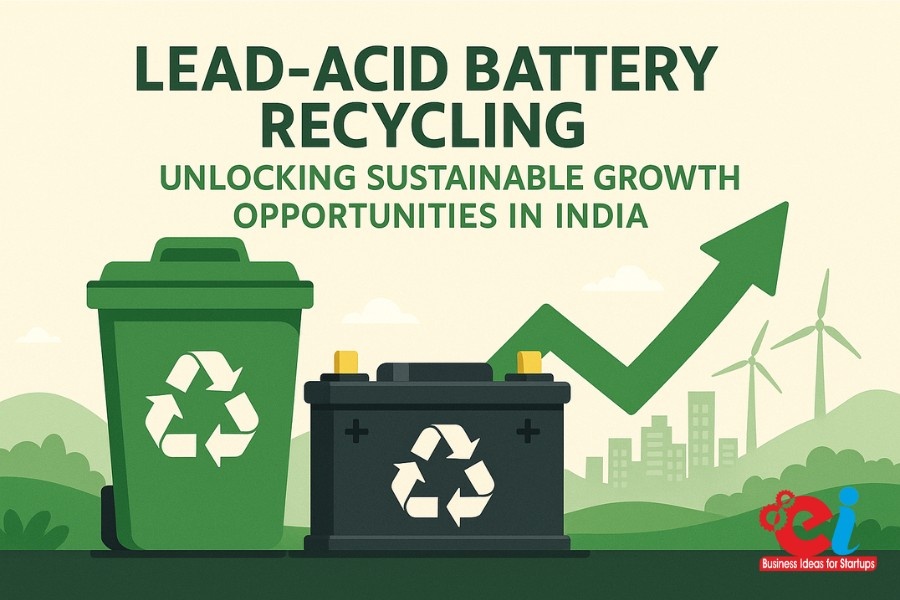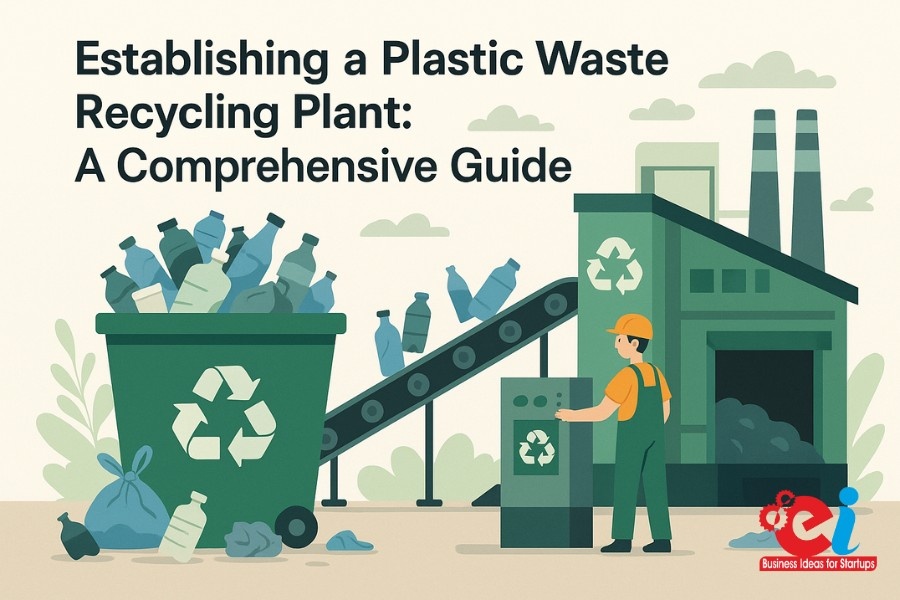The Lead Acid Battery Recycling has become an environmentally and economically profitable business opportunity due to India adopting a circular economy. The automotive, power backup, and renewable energy sectors are propelling industries that use lead-acid batteries. Their annual generation of over 1.2 billion scrap lead-acid batteries positions their recycling as an integral component of India’s waste management and metal recovery ecosystem.
The construction of Lead Acid Battery Recycling in rural and semi-urban areas is a unique opportunity with many challenges. These regions do not have the capacity for large-scale investment, but they do have low-cost land and abundant labor. Alongside these factors, there is also a growing demand for energy that results in significant battery waste. Small entrepreneurs who seek low-cost entry business models are able to take advantage of these conditions without compromising profitability, and compliance makes it easier to operate.
This article will highlight the insights garnered from India’s top industrial project consultancy firm NPCS about effective lead recovery from scrap batteries in lower-cost lead recycling units.
1. Understanding The Business Potential Of Lead Acid Battery Recycling
The Need For Lead Acid Battery Recycling
- 85% of the lead consumed in India is used by battery manufacturers.
- Used lead-acid batteries (ULABs) are the most efficient source of secondary lead.
- Lead is 100% recyclable without any loss in properties.
Primary Drivers of India’s Domestic Lead Requirement
- Growth in the Automotive Industry
- Inverter and UPS Consumption
- Expansion of Solar Batteries in Rural India
Snapshot of the Market
- Estimated value of India’s lead recycling industry: ₹7,500 Crores
- Global lead market growth rate (CAGR): 5.6% (2023 – 2030)
- Rise in EVs and renewable energy backup systems = More scrap batteries
Related: Start Lithium-ion Battery Recycling Business
2. Types of Lead Recycling Models
| Model | Components | Description | Scale | Investment |
| Model 1 | Manual Battery Breaking + Furnace Smelting | Manual breaking, basic wet scrubbers | 2–5 MT/day | ₹25–₹35 Lakhs |
| Model 2 | Semi Mechanized Breaking + Rotary Furnace | Cutter with conveyor, cyclone separator + scrubber | 5–10 MT/day | ₹40–₹70 Lakhs |
| Model 3 | Micro-grid Linked Solar Battery Recycling (Cluster Model) | SHG-run collection, solar-powered mini-plant | 3–5 MT/day | Government/CSR Funded |
3. Key Machinery and Equipment for Low-Cost Lead Recovery Units
| Equipment | Function | Apportioned Cost (INR) |
| Manual Battery Cutting Tools | Scrap battery dismantling | ₹20,000 – ₹50,000 |
| Battery Cutting Machine (Optional) | Semi-automated splitting | ₹2–3 Lakhs |
| Lead Smelting Furnace | Melts and extracts lead | ₹10–20 Lakhs |
| Pollution Control System | Scrubber, cooling tower, stack | ₹5–10 Lakhs |
| Mold for Lead Ingots | Casts molten lead | ₹50,000 – ₹1 Lakh |
| Acid Neutralization Tank | Treats electrolyte waste | ₹1–2 Lakhs |
NIIR Project Consultancy Services provides a full machinery list, supplier database, and layout plans optimized for rural locations.
4. Raw Materials and Input Sources
Primary Input
- Used Lead Acid Batteries (ULAB)
Battery Components Recovered
- Plates
- Grids
- Terminals
- Sulfuric Acid (requires neutralization)
- Plastic casing (shredded as plastic scrap)
Battery Collection Sources
- Regional automotive garages
- Inverter service centers
- Telecom towers
- Scrap aggregators
- Solar microgrid operators
- Municipal e-waste hubs
Localized buyback programs can incentivize battery returns.
Related: Start a Profitable Lead Recovery Business from Scrap Batteries
5. Licences and Legal Aspects of Lead Recycling
Key Licences Required
- Company Registration (MSME/Udyam)
- Consent to Establish and Operate – from SPCB
- Hazardous Waste Rules, 2016 – Licensing
- CPCB Registration for Battery Waste Management
- Factory License under Factories Act, 1948
- Fire Safety Certificate from Local Fire Department
- GST Registration and PAN
NPCS supports clients in document preparation and coordination with pollution control boards.
6. Environmental and Safety Precautions
Pollution Control Measures
- Wet scrubbers for flue gas treatment
- Bag filters for lead dust control
- Effluent tanks for electrolyte acid neutralization
- Guard enclosures and use of PPE
Worker Safety Measures
- Gloves, respiratory devices, masks
- Monitoring lead exposure
- Routine medical check-ups via local hospitals
Compliance is non-negotiable in handling hazardous materials like lead.
7. Supporting Public Policies Alongside Possible Funding
Key Support Schemes
- PMEGP Scheme – Loans up to ₹25 Lakhs (15–35% subsidy)
- CGTMSE – Credit guarantee support
- SIDBI Green Finance – For eco-friendly businesses
- CSR Grants – For cluster/women-led units
- State Industrial Subsidies – For pollution control and infrastructure
NPCS guides clients through grant applications, business planning, and cluster model collaborations.
8. In What Ways NIIR Project Consultancy Services (NPCS) Can Aid
NPCS Turnkey Services Include:
- Detailed Project Reports (DPRs)
- Market Feasibility & SWOT Analysis
- Cost & Profit Forecasting
- Machinery Supplier Linkages
- Pollution Control Guidance
- Legal License Documentation
- Bank Loan and Subsidy Application Support
Summary
Exemplified in this business concept is a recirculatory system that efficiently capitalizes on the Lead Acid Battery Recycling, from an economic periphery, as an environmentally beneficial approach. There is a wonderful opportunity to set up decentralized, compliant, and job-providing lead recycling units in rural and semi-urban areas in India owing to the low-cost models.
With a modest sum of investment, a strong local collection network, plus the guidance of NIIR Project Consultancy Services, entrepreneurs can meet the market’s demands while protecting the environment.
Be among the very first participants in the new form of green entrepreneurship: sustainably powering India by smartly recycling and lead.

























